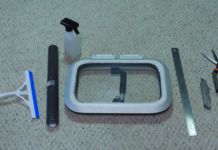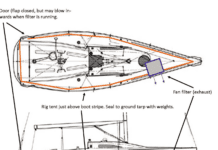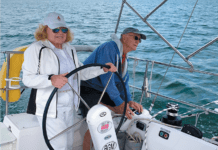Excerpted from How to Sail Around the World
When searching for a boat to buy, you need to answer a few questions. One is What size boat can you handle?
The larger the yacht, the more skill and muscle you need to deal with her. She may have bigger winches, but they will be harder to crank. Hoisting or furling a 500 to 600-square-foot mainsail on a 50-footer is easy to joke about in a yacht brokers office, but can be a surprising handful for you to deal with in a breeze at night. Just because a yacht has a powerful engine, doesn’t mean she will be easy to manage in a windy docking station.
I think all experienced world cruisers will agree that learning how to enter and leave tight spots under sail is a skill you should have in your pocket. Unfortunately this is completely alien to present-day U.S. marina type sailing, in which a person motors out from a dock, puts up the sails, goes out for a few hours, and does the same routine in the opposite order when she returns.
You may scoff at this, but if youre in distant waters and there are problems (engine not working, a line around the propeller, dead batteries), you will be very glad to know how to work yourself in and out of restricted waters.
Suppose you want to take fuel and water from a dock against which a fresh breeze is blowing. Do you know how to drop an anchor when youre going into the dock so that you can pull yourself off when youre ready to leave? If youre anchored near a rocky shore and the wind shifts and begins to blow toward the land, do you know how to sail out the anchor without winding up on the rocks? These techniques are not hard to master, but its smart to practice them regularly. It may be useful to learn these maneuvers in a small sailboat and then work up in size because of the considerable weight and the restricted turning ability of a bigger boat. Mistakes are unthinkable and can cost thousands of dollars.
Don’t consider close-order maneuvering under sail a troublesome thing to learn. Its challenging and great fun to sail in and out of tight corners. Half the time its just a matter of turning the yacht to head downwind, paying attention to any tidal stream or river current, carefully checking for traffic, and hoisting a jib. Then you let go off the stern lines or haul up a stern anchor, and youre away. Once you have a little sea room, you can hoist the mainsail.
The other half of the time, it requires more study, care, and practice. One person must be in absolute control. You need to figure out exactly what youre going to do, have every bit of your gear ready, and have an alternate plan if possible, and carefully explain whats in your head to each person involved. Often you need to use lines to warp the vessel around to another dock or turn her so that the wind is more suitable. Again, you must check the tidal stream and current if theyre factors.
A way of practicing these maneuvers without embarrassment is to go to a safe, shallow, deserted anchorage. Drop a fender on a light anchor for a mark and use it as a practice target for sailing out the anchor and other procedures.
For more cruising lessons, advice and stories, purchase Hal Roths How to Sail Around the World from Practical Sailor.






































